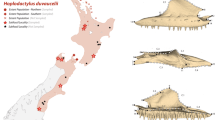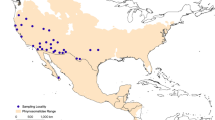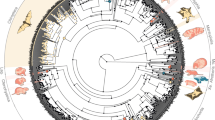Abstract
Extant species of Xenarthra represent a severely restricted sample of the total diversity achieved by the group. Given their shared history, the extant representatives of the three major groups of xenarthrans (Cingulata, Folivora, and Vermilingua) provide a valuable basis for paleobiological inference. However, many extinct taxa are morphologically so dissimilar from their extant relatives that they suggest very different ways of life. In these cases, extinct forms do not have modern models within the group and the application of a simplistic and strict approach can produce nonsensical reconstructions. In this contribution, we evaluate the limitations of the use of extant xenarthrans as morphological models for paleobiological reconstructions. A database of linear dimensions of the appendicular skeleton of extant and extinct xenarthrans and other mammals (marsupials, carnivorans, rodents, primates, perissodactyls, artiodactyls, and proboscideans) was constructed. Exploratory analyzes were performed on general morphometric similarity between existing and extinct xenarthrans (PCA) and the accuracy of body mass estimates of extinct xenarthrans based on their close relatives and other mammals (simple and multiple linear regressions) were tested. Extinct xenarthrans occupy similar relative positions in the morphospaces as extant mammals other than their closest relatives. Most allometric equations, particularly those based only on xenarthrans, produced remarkable underestimates. This can be explained by dimensional differences (up to four orders of magnitude) and shape differences between most of the extinct and extant xenarthrans. This does not invalidate actualism and the use of analogues, but suggests the need to apply other approaches, such as mechanics, that address form-function relationships but are not necessarily based on known biological comparators.






Similar content being viewed by others
References
Amson E, Nyakatura JA (2017) The postcranial musculoskeletal system of xenarthrans: insights from over two centuries of research and future directions. J Mammal Evol (this special issue)
Asher RJ, Bennett N, Lehmann T (2009) The new framework for understanding placental mammal evolution. BioEssays 31:853–864
Asher RJ, Helgen KM (2010) Nomenclature and placental mammal phylogeny. BMC Evol Biol 10:1–9
Asher RJ, Lehmann T (2008) Dental eruption in afrotherian mammals. BMC Biology 6:14
Bargo MS, Toledo N, Vizcaíno SF (2012) Paleobiology of the Santacrucian sloths and anteaters (Xenarthra, Pilosa). In: Vizcaíno SF, Kay RF, Bargo MS, (eds) Early Miocene Paleobiology in Patagonia: High-latitude Paleocommunities of the Santa Cruz Formation. Cambridge University Press, Cambridge, pp 216–242
Bargo MS, Vizcaíno SF, Archuby FM, Blanco RE (2000) Limb bones proportions, strength and digging in some Lujanian (late Pleistocene-early Holocene) mylodontid ground sloths (Mammalia. Xenarthra). J Vertebr Paleontol 20:601–610
Croft DA (2001) Cenozoic environmental change in South America as indicated by mammalian body size distributions (cenograms). Diversity Distrib 7:271–287
Currie A (2013) Convergence as evidence. Brit J Philos Sci 64:763–786
Currie A (2015) Marsupial lions and methodological omnivory: function, success and reconstruction in paleobiology. Biol Phil 30:187–209
Damuth J, McFadden BJ. (1990) Body Size in Mammalian Paleobiology. Estimation and Biological Implications. Cambridge University Press, Cambridge.
De Esteban-Trivigno S, Mendoza M, De Renzi M (2008) Body mass estimation in Xenarthra: a predictive equation suitable for all quadrupedal terrestrial placentals? J Morphol 269:1276–1293
Delsuc F, Douzery EJP (2008) Recent advances and future prospects in xenarthran molecular phylogenetics. In: Vizcaíno SF, Loughry WJ (eds) The Biology of the Xenarthra. University Press of Florida, Gainesville, pp 11–23
Duan N (1983) Smearing estimate: a nonparametric retransformation method. J Am Stat Assoc 78:605–610.
Fariña RA (1995). Limb bone strength and habits in large glyptodonts. Lethaia 28:189–196
Fariña RA, Vizcaíno SF, Bargo MS (1998) Body mass estimation in Lujanian (late Pleistocene-early Holocene of South America) mammal megafauna. Mastozool Neotropical 51:87–108
Gardner AL (2005a) Order Cingulata. In: Wilson DE, Reeder DM (eds) Mammal Species of the World: A Taxonomic and Geographic Reference, Third Edition. The Johns Hopkins University Press, Baltimore, pp 94–99
Gardner AL (2005b) Order Pilosa. In: Wilson DE, Reeder DM (eds) Mammal Species of the World: A Taxonomic and Geographic Reference, Third Edition. The Johns Hopkins University Press, Baltimore, pp 100–103
McDonald HG (2005) Paleoecology of extinct xenarthrans and the Great American Biotic Interchange. Bulletin of the Florida Museum of Natural History 45:313–333
McDonald HG, De Iuliis G (2008) Fossil history of sloths. In: Vizcaíno SF, Loughry WJ (eds) Biology of the Xenarthra. University of Florida Press, Gainesville, pp 24–36
Meredith RW, Janečka JE, Gatesy J, Ryder OA, Fisher CA, Teeling EC, Goodbla Al, Eizirik E, Simão TLL, Stadler T, Rabosky DL, Honeycutt RL, Flynn JJ, Ingram CM, Steiner C, Williams TL, Robinson TJ, Burk-Herrick A, Westerman M, Ayoub NA, Springer MS, Murphy WJ (2011) Impacts of the Cretaceous terrestrial revolution and KPg extinction on mammal diversification. Science 334:521–524
Milne N, O’Higgins (2012) Scaling of form and function in the xenarthran femur: a 100 fold increase in body mass is mitigated by repositioning of the third trochanter. Proc R Soc B 279:3449–3456.
Milne N, Toledo N, Vizcaíno SF (2012) Allometric and group differences in the xenarthran femur. J Mammal Evol 19:199–208
Milne N, Vizcaíno SF, Fernicola JC (2009) A 3D geometric morphometric analysis of digging ability in the extant and fossil cingulate humerus. J Zool 278:48–56
O’Leary MA, Bloch JI, Flynn JJ, Gaudin TJ, Giallombardo A, Giannini NP, Goldberg SL, Kraatz BP, Luo Z-X, Meng J, Ni X, Novacek MJ, Perini FA, Randall ZS, Rougier GW, Sargis EJ, Silcox MT, Simmons NB, Spaulding M, Velazco PM, Weksler M, Wible JR, Cirranello AL (2013) The placental mammal ancestor and the post-K-Pg radiation of placentals. Science 339:662–667
R Development Core Team (2008) R: a language and environment for statistical computing. R Foundation for Statistical Computing, Vienna, Austria. URL http://www.R-project.org
Rudwick MJS (1964) The inference of function from structure in fossils. The British J Phil Sc 15:27–40
Toledo N (2016) Paleobiological integration of Santacrucian sloths (early Miocene of Patagonia). Ameghiniana 53:100–141
Toledo, N, Bargo, MS, Cassini, GH, Vizcaíno SF (2012) The forelimb of early Miocene sloths (Mammalia, Xenarthra, Folivora): morphometrics and functional implications for substrate preferences. J Mammal Evol 19(3):185–198
Toledo N, Cassini GH, Vizcaíno SF, Bargo MS (2014) Mass estimation of Santacrucian sloths from the early Miocene Santa Cruz formation of Patagonia, Argentina. Acta Palaeontol Pol 59:267–280
Vizcaíno SF (2009) The teeth of the ‘toothless’. Novelties and key innovations in the evolution of xenarthrans (Mammalia, Xenarthra). Paleobiology 35:343–366
Vizcaíno SF (2014) Interview on paleobiology. In: Sánchez-Villagra MR, MacLeod N (eds) Issues in Palaeontology: A Global View. Interviews and Essays. Scidinge Hall Verlag, Zürich, pp 181–192
Vizcaíno SF, Bargo, MS, Cassini GH (2006) Dental occlusal surface area in relation to body mass, food habits and other biologic features in fossil xenarthrans. Ameghiniana 43:11–26
Vizcaíno SF, Bargo MS, Fariña RA (2008) Form, function and paleobiology in xenarthrans. In: Vizcaíno SF, Loughry WJ (eds) The Biology of the Xenarthra. University Press of Florida, Gainesville, pp 86–99
Vizcaíno SF, Cassini GH, Fernicola JC, Bargo MS (2011) Evaluating habitats and feeding habits through ecomorphological features in glyptodonts (Mammalia, Xenarthra). Ameghiniana 48: 305–319
Vizcaíno SF, Cassini GH, Toledo N, Bargo MS (2012) On the evolution of large size in mammalian herbivores of Cenozoic faunas of South America. In: Patterson BD, Costa, LP (eds), Bones, Clones, and Biomes: the History and Geography of Recent Neotropical Mammals. University of Chicago Press, Chicago, pp. 76–101
Vizcaíno SF, De Iuliis G (2003) Evidence for advanced carnivory in fossil armadillos. Paleobiology 29:123–138
Vizcaíno SF, Loughry WJ (2008) Xenarthran biology: past, present and future. In: Vizcaíno SF, Loughry WJ (eds) The Biology of the Xenarthra. University Press of Florida, Gainesville, pp 1–7
Vizcaíno SF, Zárate M, Bargo MS, Dondas A (2001) Pleistocene burrows in the Mar del Plata area (Buenos Aires Province, Argentina) and their probable builders. Acta Palaeontol Pol 46:157–169
Wheeler RE (2016) Permutation tests for linear models in R. https://cran.r-project.org/web/packages/lmPerm/lmPerm.pdf
White JL (1993) Indicators of locomotor habits in xenarthrans: evidence for locomotor heterogeneity among fossil sloths. J Vertebr Paleontol 13:230–242
White JL (1997) Locomotor adaptations in Miocene xenarthrans. In: Kay RF, Madden RH, Cifelli RL, Flynn JJ (eds) Vertebrate Paleontology in the Neotropics. The Miocene Fauna of La Venta, Colombia. Smithsonian Institution Press, Washington, D.C., pp 246–264
Wickham H (2009) ggplot2: elegant graphics for data analysis. Springer-Verlag, New York
Wildman DE, Uddin M, Opazo JC, Liu G, Lefort V, Guindon S, Gascuel O, Grossman LI, Romero R, Goodman M (2007) Genomics, biogeography, and the diversification of placental mammals. Proc Nat Acad Sci USA 104:14395–14400
Acknowledgements
This contribution was presented during the ICVM 11 meeting in Bethesda (Washington DC) in July 2016, as part of the symposium Morphology and Evolution of the Xenarthra organized by M. Susana Bargo and John A. Nyakatura. Attendance to the congress was partially granted by UNLP Viajes y Estadías 2016 to SFV and NT, and CIC 1827/15 (Comisión de Investigaciones Científicas de la provincia de Buenos Aires) to MSB. This is a contribution to the projects UNLP 11/N750 (Universidad Nacional de La Plata) and PICT 2013-0386 and 0389 (Agencia Nacional de Promoción Científica y Tecnológica). We thank the two anonymous reviewers for their comments, which not only improved this manuscript but inspired future work.
Author information
Authors and Affiliations
Corresponding author
Rights and permissions
About this article
Cite this article
Vizcaíno, S.F., Toledo, N. & Bargo, M. Advantages and Limitations in the Use of Extant Xenarthrans (Mammalia) as Morphological Models for Paleobiological Reconstruction. J Mammal Evol 25, 495–505 (2018). https://doi.org/10.1007/s10914-017-9400-2
Published:
Issue Date:
DOI: https://doi.org/10.1007/s10914-017-9400-2




